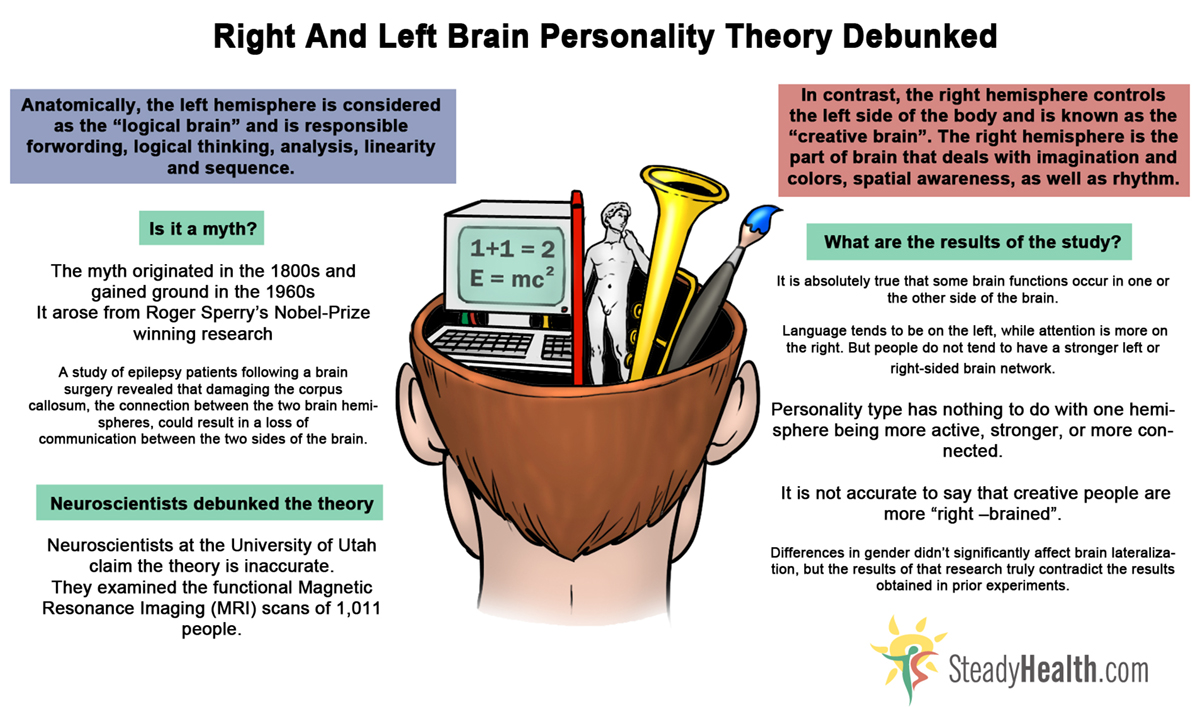Table of Contents
The human brain is organized in a manner identical to that of other mammals. However, it is considerably larger in size. The brain can be described as being divided into left and right cerebral hemispheres, which individually are often referred to as ‘right and left brain.’ The two hemispheres are connected by an intricate network of nerve fibers called the corpus callosum.
This is process is known as lateralization.
Anatomical organization of the brain
Anatomically, the left hemisphere is considered as the “logical brain” and is responsible for wording, logical thinking, analysis, linearity and sequence. The left brain also controls the right side of the body.
In contrast, the right hemisphere controls the left side of the body and is known as the “creative brain”. The right hemisphere is the part of brain that deals with imagination and colors, spatial awareness, as well as rhythm.
This myth originated in the 1800s, following several scientific researches that demonstrated that severing one side of the brain could lead to a loss of specific abilities. The myth gained ground in the 1960s and might have arisen from Roger Sperry’s Nobel Prize winning research; with his study of epilepsy patients following a brain surgery. The study revealed that damaging the corpus callosum, the connection between the two brain hemispheres could result in a loss of communication between the two sides of the brain.
For instance, when one patient was asked what he wanted to do, his left brain responded with “draftsman” but his right brain responded with “automobile racer.”
"Right" and "left" brainers: myth or reality?
The neuroscience community never bought into this notion. Today, thanks to the evolution in technology and medical research, physicians and scientists are better able to understand the functioning of the brain. According to the neuroscientists at the University of Utah, the theory that ‘right brainers’ are more creative and thoughtful and the ‘left brainers’ are more logical and detail-oriented is absolutely inaccurate.
Researchers have done much to debunk this idea. Over a period of two years, researchers examined the functional Magnetic Resonance Imaging (MRI) scans of 1,011 people within the ages of seven and twenty-nine from a database called the International Neuroimaging Data-Sharing Initiative (INDI). Each subject was asked to lie in the scanner, thinking about nothing in particular for 5 to 10 minutes, and their brain activity was recorded and analyzed for evidence of increased activity in either the left or right sides of the brain.
In total, 7,266 distinct regions of the brain were identified and researchers examined the areas that were the most lateralized. In lateralization, certain mental processes are specifically attributed either to the right side, or to the main side of the brain. Functional lateralization of these regions in each participant’s brain was studied and no evidence was found that individuals preferentially use their left brain or right brain network more often than the other. Dr. Jeff Anderson, the lead author of the study stated:
- Mindmap by steadyhealth.com
- Photo courtesy of Ed Yourdon by Flickr : www.flickr.com/photos/yourdon/2626762006/
- www.medicaldaily.com/are-you-right-brained-or-left-brained-personality-type-brain-scientists-say-theres-no-such-thing
- http://www.plosone.org/article/info%3Adoi%2F10.1371%2Fjournal.pone.0071275#s3
- www.livescience.com/39373-left-brain-right-brain-myth.html
- en.wikipedia.org/wiki/Phrenology


